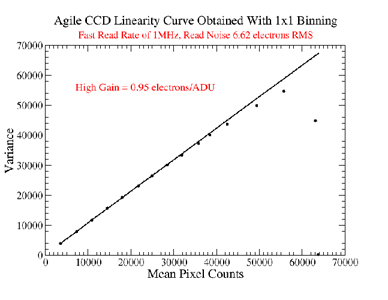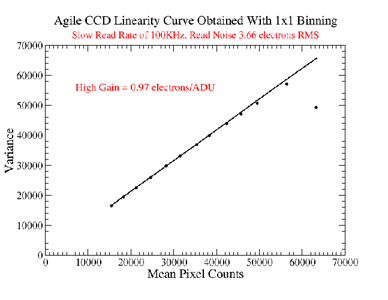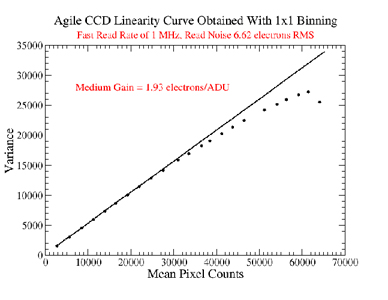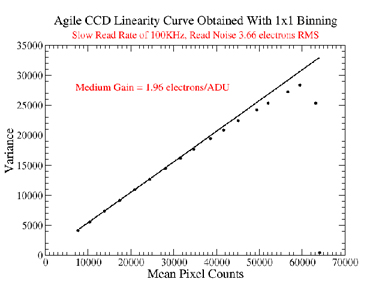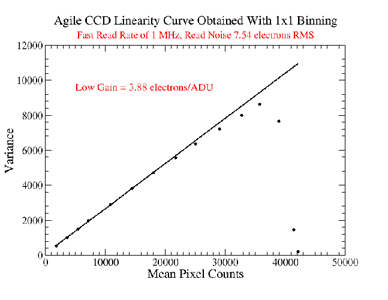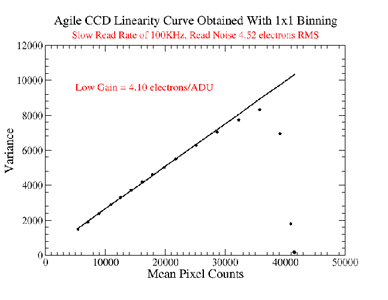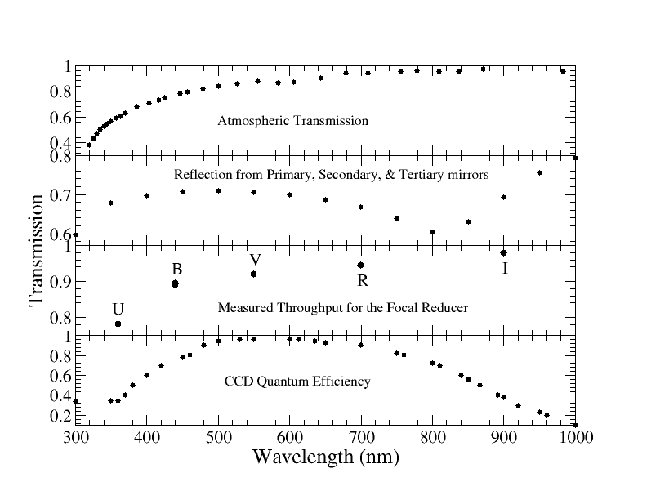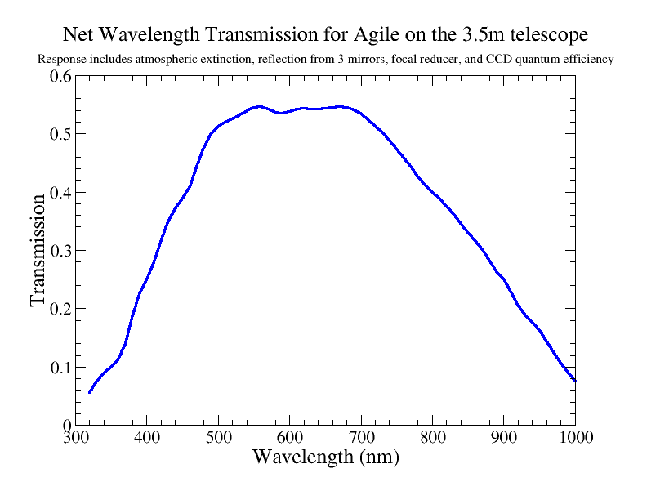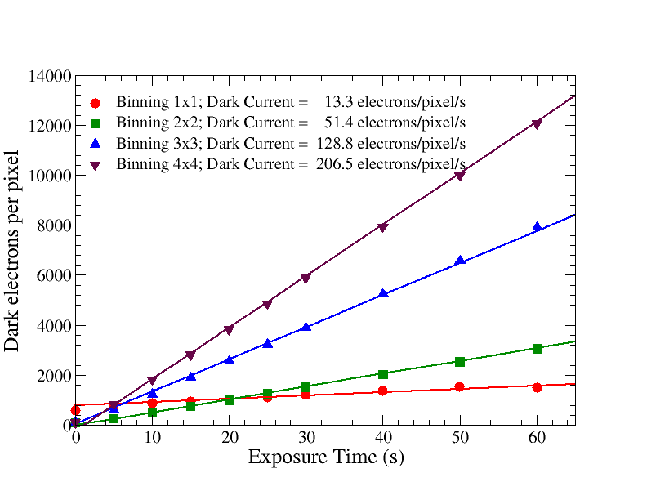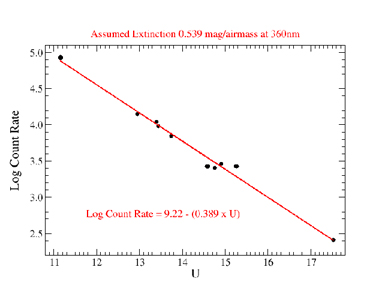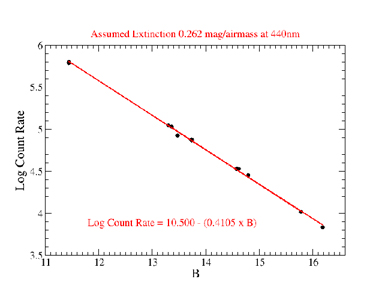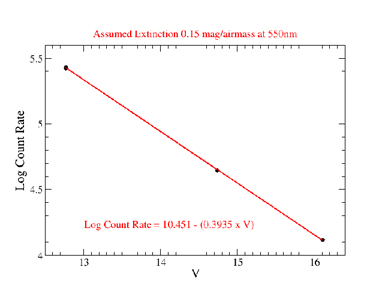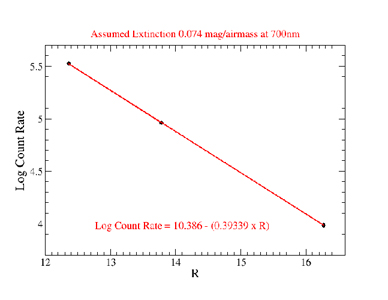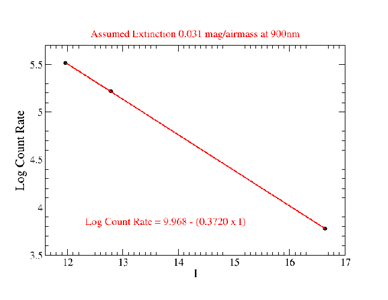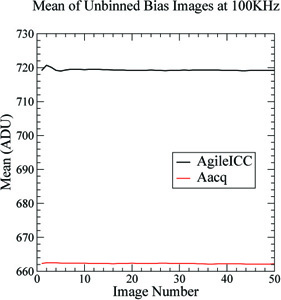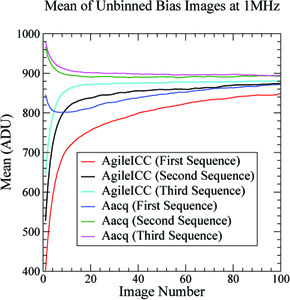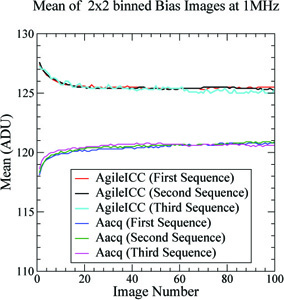
ARC 3.5m | Agile
Last updated: Feb 23, 2016 - AB
Also please be aware of the data corruption issue in section 5.2
Table of Contents
Agile is a high-speed time-series CCD photometer based on the original design of Argos, a timeseries photometer at the 2.1m telescope at McDonald Observatory (Nather & Mukadam 2004). Agile comprises of a Princeton Instruments Micromax camera with a frame transfer CCD, which has 1Kx1K active pixels, each of size 13×x3 Using a focal reducer at the Nasmyth focus of the 3.5m telescope at Apache Point Observatory (APO), we yield a field of view of approximately 2.5 arcmin×2.5 arcmin with an unbinned platescale of 0.130 arcsec/pixel1. The CCD is back-illuminated and thinned for improved blue sensitivity and provides a quantum efficiency ≥ 80% in the wavelength range 450–750 nm. The unbinned full frame readout time can be as fast as 1.1 s; this is achieved using a low noise amplifier operating at 1MHz with an average read noise of order 6.6 ē RMS2. At the slow read rate of 100 KHz to be used for exposure times longer than a few seconds, we determine an average read noise of order 3.7 ē RMS3.
Device E2V Technologies CCD 47-20 Active Pixels 1024 × 1024 Pixel Size 13 µ × 13 µ Field of View1 2.2 arcmin×2.2 arcmin Platescale1 0.258 arcsec/pixel, binned 2x2 Fast Readout Read Rate 1 MHz; Read Noise 6.62 ē RMS2 Slow Readout Read Rate 100 KHz; Read Noise 3.66 ē RMS3 Dark Current 13.3 electrons/pixel/s Table 1: Agile: Summary of Features
1 Agile can also be requested without the focal reducer for very special science objectives. Without the focal reducer, the field of view is merely 1.3 arcmin×1.3 arcmin with an unbinned platescale of 0.077 arcsec/pixel.
2 The read noise is measured to be 7.54 ē RMS at the read rate of 1MHz with the low gain setting.
3 The read noise is measured to be 4.52 ē RMS at the read rate of 100 KHz with the low gain setting.
2. Instrument Design and Operation
Understanding the instrument design of Agile should help the observer choose a suitable exposure time and a configuration for observing, and learn the implications of these choices.
2.1. Choosing an exposure time
- Agile is a frame transfer CCD camera. The CCD has 1K×2K pixels, half of which are active and exposed to light and the other half are masked from light. At the end of an exposure, the image from the active region of the CCD is transferred to the masked portion in hundreds of microseconds. This process is known as a frame transfer. The transferred image can be read out slowly from the masked portion, while a new exposure can commencein the active region of the CCD. As a result, the dead time between consecutive exposures is a fraction of a millisecond. Observers can choose an exposure time and windowing knowing that readout time does not contribute to any dead time between exposures.
- Agile does not have a mechanical shutter. The frame transfer operation of the CCD is utilized to end an exposure and initiate the subsequent new exposure, and it is triggered by the negative edge of a pulse. Housed in the data acquisition computer Nimble is a Brandywine GPS card that is synchronized to the Observatory’s GPS clock. When the observer requests an exposure time of n seconds, the GPS-based timer card generates a train of pulses with an even spacing of n seconds. These GPS-synchronized pulses are transmitted to the camera controller, and their negative edges effectively dictate both the start and end of each exposure. Therefore we expect that both the exposure start and the exposure duration should have an uncertainty smaller than a millisecond.
- Operating the instrument in the manner described above requires that the desired exposure time should always be greater than the sum of the CCD readout time (with the chosen binning and windowing) and the time required to write the image to disk. The data acquisition program typically needs a hundredth of a second to write the image in the buffer to a local disk. Hence we conservatively require that the exposure time must be greater than the CCD readout time by at least 0.03 s to account for the jitter in readout time and the time to write the image to disk.
Table 2: Exposure time must be greater than the readout time by at least 0.03 s.
Read Rate Binning Readout Time (s) Minimum Exposure Time for Full Frame Images (s) 1 MHz 1 MHz 1 MHz 100 KHz 100 KHz 100 KHz
- The Agile CCD camera has two readout amplifiers, one of which is capable of reading at the fast readrate of 1MHz while introducing a read noise of order 7 ē RMS, and the other capable of reading at 100 KHz with a low read noise of order 4 ē RMS. Once the observer chooses the binning and windowing configuration and specifies an exposure time, the software will select the slowest read rate that satisfies the above condition. The read rate and exact read noise values will be included in the FITS headers.
- The chosen exposure time must additionally satisfy the constraint 0.3 ≤ Exptime ≤ 655.34 s; this excludes bias frames. Please note that we are presently unable to test the accuracy of absolute or relative timing for exposure times shorter than 0.3 s. The constraint on the maximum exposure time is due to the GPS timer card. The constraint on the minimum exposure time is presently due to the software. Should observers require to push this limit for scientific reasons, we can work hard to modify the software and conduct extensive timing tests to allow exposure times smaller than 0.3 s. The exposure time should also be an integral multiple of 0.02 s (present software restriction).
- It is also possible to operate the CCD camera without controlling the exposure time using GPS-synchronized pulses. This mode is presently enabled to allow the observer to acquire bias frames, and gets activated whenever the exposure time is set to zero. However if in the future several observers indicate that their science would benefit from exposure times longer than 655.34 s inspite of the high dark current, we can enable the use of internal timing for substantially long exposures acquired at the cost of reduced timing accuracy. We expect the uncertainty in timing may then be of the order of a hundredth of a second or more. Operated in this fashion, Agile will just be an imaging system and should not then be called a timeseries photometer.
The photons incident on a CCD are converted into electrons due to the photoelectric effect. The CCD gain effectively decides how many counts or ADU (Analog to Digital Units) we get for the accrued electrons. The Agile CCD camera offers three choices of gain: high, medium, and low; these choices have slightly different values under the two different read rates, as shown in the table below.
Read Rate Gain 1 MHz High = 0.95 1 MHz Medium = 1.93 1 MHz Low = 3.88 100 KHz High = 0.97 100 KHz Medium = 1.96 100 KHz Low = 4.10 Table 3: The three different choices of gain have slightly different values depending on the read rate. The correct value is automatically entered in the acquired FITS images.
The values of gain may appear to be counter-intuitive, but make sense when we think in terms of the net ADU counts. For example at the read rate of 1 MHz, the high gain setting will yield 31580 ADU or counts for 30000 electrons, while the medium gain setting will yield 15540 counts, and the low gain setting will yield 7730 counts for the same number of electrons. The observer must select the gain setting so that at the desired exposure time, the stars of interest have counts in the linear regime of the CCD, while utilizing the dynamic range well. Please note that when using the low gain setting and binning 1x1, the CCD will saturate at about 43000 counts. However when binning 2x2, the saturation point is always given by the digitization limit of 65535 counts.
The examples below are meant to be an illustration on how to decide between the different choices of gain:
• Suppose a bright star observer was getting 50000 counts/pixel (non-linear regime) at the peak of the stellar profile in a one second exposure at the default setting of medium gain ~2. Should this observer switch the CCD gain to low ~1, he/she will now derive about 25000 counts at the peak pixel during the one second exposure. This lower value is well within the linear regime of the CCD, and allows the observer to continue acquiring data at the same exposure time. This observer could also choose to expose the CCD for 0.5 s instead to reduce the counts, but would end up increasing the effect of read noise in his/her data as he/she would be reading out twice in a second instead of once a second with the low gain setting.
• Similarly, suppose another observer was acquiring 15000 counts/pixel at the peak pixel of his/her star. This observer could either increase the exposure time by two or simply increase the gain from medium ~2 to high ~4. The observer could thus use the CCD gain to his/her advantage to get twice the count rate, utilizing the dynamic range well, and without decreasing the effective time resolution.
• On the other hand, consider an observer with a faint target and relatively bright comparison stars. This observer could switch the CCD gain to high, but perhaps such an action would bring the bright comparison stars in the nonlinear regime of the CCD or close to saturation even. The observer could switch to low CCD gain as in the first example, but that could bring his/her target star of interest to very low counts. It would be better for such an observer to stay with the default choice of medium gain, so as to get reasonable counts for both the faint target star and the brighter comparison stars.
2.3 Choices of Available Filters
All square filters listed in the online filter inventory (with the exception of the Sloan set dedicated to Agile FW 2) are
available for use in Agile’s filter slide; However, currently on one filter can be loaded at a time.
Agile is operated within the Telescope User Interface (TUI) software written and maintained by Russell Owen at the University of Washington. A detailed manual is available at under the top menu Telescope->TUI->Manual. The main TUI status window is shown below.
The instrument is configured using the Agile window accessible under the Instrument menu from the main TUI window. This brings up the following Agile control Graphic User Interface (GUI).
The Agile instrument exposure control is in standard TUI format (for detailed description see here ), and, as for other instruments, shows status of the current exposure at the top, and allows you to set the object Type (for the FITS image header), exposure Time, number of Exposures, and root File Name. If you wish to add comments to the file header, place them in the Comments field.
All data will automatically be stored on arc-gateway under /export/images/<program ID>/<filename>. However, most users set TUI up to automatically transfer images to their local computer using the Preferences options in the main TUI window menu (see AutoGet and Save To options under Exposures). You can also define a subdirectory (TUI will even create it for you) by entering a name such as <subdir1>/<subdir2>/<filename> ; note, however, that a separate image number sequence will be started in each subdirectory.
The FITS header for each image stores the exposure time values (duration, start, stop) plus telescope parameters for future reference.
The Start button begins the exposure or exposure sequence.
- Start - This button starts the exposure or exposure sequence.
- Pause - This button pauses the exposure, you can start it again later.
- Abort - This button aborts an exposure and the sequence.
- NOTE: Currently clicking Abort puts the agile Expose GUI into a strange unresponsive state. The Obs-Spec can clear this for you. However, it is important that once the Abort button is clicked no other commands are sent from this window UNTIL the Obs-Spec has cleared it for you. When possible please warn the Obs-Spec when you intend to use the Abort button.
We have moved Agile to its own permanent port at TR2. This creates some changes for users who are familiar with Agile at NA2. Please see Sec 5.3.New Port Issues.
The telescope is focused by inspection of Agile images. As with all instruments, monitoring focus is advisable, as it will change over the course of the night, especially at the beginning of the night before the telescope has reached equilibrium.
There is more to time-series photometry than meets the eye; it is not just relative photometry with a precise measurement of the observation epoch. A good time series photometer not only requires a precise measurement of the start time of an exposure, but also as precise a measurement of the duration of the exposure. Besides accuracy in timing, a good time-series photometer must be able to provide sufficient time resolution to sample the variable phenomena well. This requires that the photometer allow short exposure times and also include insignificant dead times between consecutive exposures. Frame transfer CCDs are ideal for time-series photometry as they can provide contiguous exposures with no dead time.
The PC clock of the data acquisition computer Nimble is disciplined via the Network Time Protocol (NTP) using the time server galileo.apo.nmsu.edu, which is in turn disciplined by the Observatory’s GPS clock. Time in the CCD images at the accuracy of an integral second comes via the NTPdisciplined Nimble clock. Nimble houses a Brandywine GPS card that is also synchronized to the Observatory’s GPS clock. Sub-second absolute timing up to the accuracy of a millisecond in the CCD images comes from this internal GPS card.
The GPS timer card internal to Nimble is programmable and capable of producing a heartbeat (train of pulses) at the desired exposure time. The negative edges of these pulses trigger the frame transfer operation, ending the ongoing exposure and starting a new one. The relative timing is thus controlled entirely in hardware without any software intervention. The genius of this design belongs to Dr. Nather of the University of Texas at Austin, which affords us a precision in relative timing better than a millisecond.
The new Agile software written by Russell Owen includes the following tests that constantly check the relative timing as follows:
• If noise pickup in the sync pulse cable poses as false pulses, then the software will detect extra images that arrive prematurely. A premature image is one that fails to arrive within 0.2 s of the expected arrival time. The software will stop the data acquisition and report the situation to the observer. We have addressed this problem in hardware by using fiber-optic cable to transmit the GPS sync pulses from the timing card right up to the instrument. We only use a foot of co-axial cable to send the pulse to the camera controller. This cable is wrapped in aluminium tape for 100% shielding.
• Should images fail to arrive altogether, then the software will stop the data acquisition. Such an event can occur for non-zero exposure times if the sync pulses are not reaching the camera controller. Such an event may also possibly be caused by a system corruption or crash, and power cycling the instrument may be the next step. The observing specialist should be notified in either case.
We measure the read noise to be 6.62 ē RMS for the high and medium gain settings at the read rate of 1 MHz. We find that the read noise at the low gain setting is somewhat higher at 7.54 ē RMS for the read rate of 1 MHz. At the slow read rate of 100 KHz, the high and medium gain settings yield a read noise of 3.66 ē RMS and the low gain setting yields a read noise of 4.52 ē RMS.
The readout time for an unbinned full frame is 1.1 s operating at 1 MHz. With 2x2 and 3x3 binning, the readout times of a full frame reduce to about 0.462 s and 0.268 s respectively. At the slow read rate of 100 KHz, the readout time for an unbinned full frame is about 10.7 s, and with 2x2 and 3x3 binning, the readout times drop down to 3.1 s and 1.6 s respectively. The jitter in these readout times is no more than a few milliseconds, and does not affect the instrument timing at all.
Agile has two possible read rates of 1MHz and 100 KHz, and three possible gain settings of high, medium, and low. For each of the six possible combinations as above, we carried out the following process to determine values for the read rate and gain at each setting. We acquired two consecutive domeflats using the dim quartz lamp with increasing exposure times until saturation. We show the mean counts of both the images along the x axis and the variance in the difference of these images along the y axis. These CCD transfer curves obtained with 1x1 binning show the region of linearity (see Figure 1). The inverse of the slope of the linear regime gives us a value of the gain at that setting. At the read rate of 1 MHz, we determine the high, medium, and low gain settings to correspond to values of 0.95, 1.93, and 3.88 electrons/ADU respectively. At the read rate of 100 KHz, we find that the high, medium, and low gain settings correspond to 0.97, 1.96, and 4.10 electrons/ADU respectively.
3.4 Linearity & Saturation as a function of Binning and Gain
The saturation limit and shape of the linearity curve are affected by the choice of binning and gain. For example, the linearity curves shown above indicate a saturation limit of 65535 counts for 1x1 binning and high or medium gain. The saturation limit changes to ~43000 counts for 1x1 binning and low gain because it is caused by overflow of the single pixel full well. In every other case, the saturation comes from the 16-bit digitization limit, i.e. 216 − 1 = 65535.
With 2x2 binning and higher bin factors, the linear range of the CCD is extended. For example, the saturation limit for both 1x1 and 2x2 binning is given by the digitization limit of 65535 for medium gain. Binning 2x2 implies that we are packing in 4 times the number of electrons per pixel as with 1x1 binning. But since the saturation cutoff stays the same at 65535, we are effectively looking at the first quarter of the linearity curve shown for medium gain with 1x1 binning.
Figure 1: The CCD transfer curves show the linear regime of the CCD for each setting of read rate and gain. Please note that when binning 1x1 at the low gain setting, the CCD will saturate at about 43000 counts. However when binning 2x2, the saturation point is decided by the digitization limit of 65535 counts.
For higher blue quantum efficiency, we have chosen a CCD with enhanced back-thinning process and a broad-band anti-reflection coating. This gives us >80% peak quantum efficiency in the range 450–750 nm. Additionally, the CCD has an ultra-violet coating to enhance the wavelength efficiency of the region 200–370 nm to 35% (see the bottom panel of Figure 2). As Apache Point Observatory is located at an altitude of 2788 m, we expect to detect at least some of the blue photons in the range of 320–370 nm.
Figure 2 also shows the other components that shape the net wavelength response of Agile. These include the atmospheric transmission, which we actually derived using atmospheric extinction curves for CTIO. We also show the net transmission after reflections off the primary, secondary, and tertiary mirrors of the 3.5m telescope. We generated these curves using reflectivity measurements of the freshly coated 2.5m SDSS mirror. The mirrors of the 3.5m telescope also have aluminium coatings deposited using similar processes.
In photometric weather, we measured the throughput of the instrument by observing standard stars with and without the two-lens focal reducer that forms an integral part of Agile. Our measurements indicate a 0.27 mag loss of photons for the Johnson U filter, 0.12 mag loss for the B filter, 0.09 mag loss for the V filter, 0.06 mag loss for the R filter, and a 0.02 mag loss for the I filter. We also show the net transmission of the focal reducer using these broadband measurements in Figure 2.
Figure 2: We show the wavelength transmission of individual components relevant when using Agile at the 3.5m telescope. We show the atmospheric transmission (top panel), the net transmission after reflections off the primary, secondary, and tertiary mirrors of the 3.5m telescope (second panel), the throughput transmission of the focal reducer (third panel), and the Agile CCD quantum efficiency in the bottom panel.
We show the net wavelength transmission of Agile we derive after including the response of the individual components discussed above in Figure 3. We determine a peak detection efficiency of 55% at 560 nm and find that the efficiency is greater than 50% for the wavelength range 500– 730 nm. This wavelength response is only approximately correct and does not include the response of the quartz glass window in front of the CCD. Also mirror reflectivity degrades faster in the blue regime over time and our data is valid for fresh aluminium coatings. For both these reasons, the actual blue response of the instrument should be slightly less than the derived response we show in Figure 3.
Figure 3: Net wavelength transmission of Agile. Here is the data set.
3.6 Dark Current Characterization
The CCD in the camera is enclosed in vacuum and is thermo-electrically cooled to -40 C. We measured the dark counts as a function of exposure time for 1x1, 2x2, and 3x3 binning (see Figure 3) at the medium gain setting. The unbinned pixel accumulates a dark current of about 6.8 counts/s at medium gain or 13.3 electrons/s. With 2x2 binning, we expect to accumulate four times as much dark current as an unbinned pixel; our measured dark current of 51.4 electrons/pixel/s agrees with this expectation. For 3x3 and 4x4 binning, our measured values of 128.8 electrons/pixel/s and 206.5 electrons/pixel/s are consistent within uncertainties with nine and sixteen times the dark current of an unbinned pixel respectively. In general, the observer should expect a dark current of n2 times 13.3 electrons/pixel/s for nxn binning at -40 C.
Figure 4: We obtain a dark current of 13.3 electrons/pixel/s with 1x1 binning, and expect to obtain n2 times as much dark current for nxn binning.
We observed standard stars using Agile with the Johnson U, B, V, R, and I filters in photometric weather. We thank the observers who gave some of their telescope time to achieve the throughput measurements indicated below, especially Chas Miller and Eric Hilton. Since we did not acquire these measurements at zenith, we have corrected the measured counts for extinction. We show our measurements in Figure 5 and clearly indicate the assumed extinction values employed in the correction for different filters with different effective wavelengths. Using the equations of the best fit lines shown in Figure 5, we are able to derive the expected count rates for stars of different magnitudes using the Johnson U, B, V, R, and I filters. We tabulate these values below to help observers estimate an exposure time for a given target. Should the observer decide to use the medium gain setting for example, the values in the table below given in units of electrons/s should be divided by a factor of ≈2 to get an estimate of the actual count rate in units of ADU/s.
11 12 13 14 15 16 17 18 19 20 Table 4: Expected count rates in electrons/s for different magnitudes based on throughput values acquired using Johnson UBVRI filters for standard stars. Values marked by * were extrapolated.
Figure 5: Standard Star throughput values acquired using Johnson U, B, V, R, & I filters
4. Calibration Frames for processing Agile data
Bias merely refers to a positive electronic offset that is added to all pixels of the CCD image to prevent loss of low level data. This step is carried out within the electronics controller just prior to 12 digitization. A high bias value is not harmful, but a low bias value may cause the loss of low level data. Should the bias drop to extremely low values of 20 to 30 counts for 2x2 binning at the read rate of 1 MHz, please request the observing specialist to power down the camera and increase the bias offset.
A bias frame is typically acquired as an image with a zero second exposure. It contains the dark current accrued during the readout time, apart from the bias offset. The bias frame is the only type of Agile image that is acquired with internal camera timing, and for which the GPS pulses are not used to trigger the frame transfer operation. The observer should be able to use an overscan strip to subtract the correct amount of bias from each data image, and be largely immune to fluctuations in the bias. Since the readout for Agile is extremely fast, it takes a short amount of time to acquire a hundred bias frames. An observer could generate a master bias frame from the set of hundred biases, and then simply store just the master frame, deleting the rest to save disk space.
The bias value depends on the choice of read rate and binning. The change in bias with read rate can be as much as 900 counts. Observers who acquire all their data and flats at the read rate of 1MHz (short exposures) only need to obtain bias frames at 1 MHz. However observers who observe their targets at the read rate of 100 KHz (relatively longer exposures) and acquire flats at the read rate of 1MHz are recommended to obtain bias frames at both read rates.
The Agile CCD is cooled to -40 C and we measure a dark current of 13.3 electrons/s for each unbinned pixel. This instrument is meant to be used with short exposures, and hence we can get away with cooling the CCD to -40 C, relatively warm compared to other instruments. Dark frames are typically acquired using the same exposure time as the images they are meant to be subtracted from.
There is no special arrangement to acquire dome flats with Agile; it is essentially the same as with all other instruments. Dome flats can be taken by shining the truss lamps on the closed primary mirror covers. These are controlled by the Truss Lamps GUI under the Misc item in the command bar in the main TUI window.
When acquiring skyflats at dusk, please wait till the counts in a one second exposure are about 35000 counts/pixel. At that point, please initiate a series of 200 one second exposures. There are high chances that you will obtain all 200 good skyflats with this method that meet your signal-tonoise requirements. Similarly to acquire a large number of good skyflats at dawn, please initiate a series of 200 one second exposures when the counts of a one second image reach about 8000 counts/pixel. When acquiring these skyflats, please ensure that the telescope is not tracking. This eliminates the need to dither between exposures, and it is not humanly possible to dither between contiguous 1 s exposures. Keeping the stars focused during the acquisition of flats helps to ensure that in any given image, the area occupied by stars is much smaller than the field of view. Averaging a large number of such flats should result in a high quality flat field image.
We installed a mask close to the glass window above the CCD in September 2008. The purpose of the mask was to eliminate reflected light visible in flats at the 1-2%level in the form of a square-like pattern. The present flats with the mask are flat to within 0.8%, after excluding 5 rows/columns of pixels on each side. The mask causes some vignetting, but not more than 5 pixels from the edges. Excluding 10 rows/columns close to each edge, the flats appear to be flat to within 0.6%. Dividing one individual flat by a master flat (obtained by combining 200 flats) results in a scatter of 0.5%.
The present amount of vignetting should not be a serious consideration since we are losing an area of 3 arcsec × 3 arcsec close to the edges. Please let us know if you feel otherwise. The reason for not attempting to eliminate this vignetting is because of the danger of ruining the entire mask in the process. The mask has to be made manually at pixel precision.
We have had serious problems with images being corrupted, typically by ending with a run of 0s. In an attempt to avoid this the ICC automatically disconnects from the camera and reconnects after every exposure sequence. This takes roughly 20 seconds and the ICC will be unresponsive for much of that time. We don't yet know if this cures the problem or just reduces its frequency. The problem appears to be a bug in the camera control software from Princeton Instruments. They are looking into the problem.
If an image is taken whose last pixel has value 0 the ICC will output keyword BadImage=path and the FITs file will contain the keyword BadImage. This is a crude test that could fail for several reasons: an image might actually end with 0 (false positive) or it might be corrupted in some other way (false negative).
We have seen two forms of corruption that this test would miss:
- After a corrupt image that ends with a band of 0s, the next image may have a region with a strange background or gain, typically roughly the same pixels that were 0 in the previous image.
- An image may be shifted (rolled horizontally and/or vertically).
Note: the BadImage keyword is a temporary hack while we wait for a fix from Princeton Instruments. Please do not rely on it. It is intentionally not documented in the standard set of keywords below.
Image Stabilization
Also please be aware -- It has been determined that the first few images of a given sequence (a sequence includes a sequence of one, aka a single exposure) may not be stable. A simple workaround is that whenever an observer requests unbinned biases at 1MHz, all we have to do is throw out the first 10-20 images or so. Users should always take at least 30 bias frames if using fast read rate.
We have moved Agile to its own permanent port at TR2. This creates some changes for users who are familiar with Agile at NA2. Here are a few changes this move has resulted in:
1. Dome flats are currently not recommended. Test flats at TR2 have revealed some features that have not been fully explained. Sky flats are recommended.
2. There is now on-chip guiding available available in the current version of TUI (see TUI downloads page). There are several differences running this type of guider than any of the other 3.5m guiders, such as only one user at a time may run the guiding and binning is important. Please read through the associated manual included in the download package.
3. Agile now has a filter wheel installed. 6 possible filter slots can be loaded at one time. The current drawback about this set up is that 2" filters cannot be installed in these filter wheels, we still have a single 2" slide that can be put in manually. All of the 3" filters available for SPIcam can be used for Agile in the filter wheel.
Be sure to turn off any calibration lamps you may have used, then hand over the instrument by simply quitting out of the Agile instrument control window in TUI. In some circumstances, you may continue to use the instrument after your shift, e.g., you are the first half observer and the scheduled second-half observer is not using the Agile. Ask your Observing Specialist for permission to do so if circumstances warrant.
6.1 Data Storage and Retrieval
Your data will remain on arc-gateway.apo.nmsu.edu:/export/images/your program code/UTYYMMDD/ for 9 to 12 months before being automatically deleted. Data can be accessed via scp or sftp to the institutions' observer accounts on arc-gateway (you can also use ftp and the images account and password); call APO (575-437-6822) if you are unsure of the correct login.
See also the Agile Data Reduction guide.
Please find additional information for taking and reducing data here.
A. Instrument Design
Previous pdfs:
- Data Aquisition pdf from 071109
- Characterization pdf from 080201
- Setup pdf from 071108
D. Basic low-level commands (for scripting)
Agile Docs (Russell)
Troubleshooting pdf (Anjum) 071108
Acknowledgement: We thank the National Science Foundation (NSF) for the grant AST-0607840 that allowed us to assemble Agile. Partial support for this photometer was provided by NASA through the Hubble Fellowship grant HST-HF-01175.01-A awarded by the Space Telescope Science Institute, which is operated by the Association of Universities for Research in Astronomy, Inc., for NASA, under contract NAS 5-26555.


